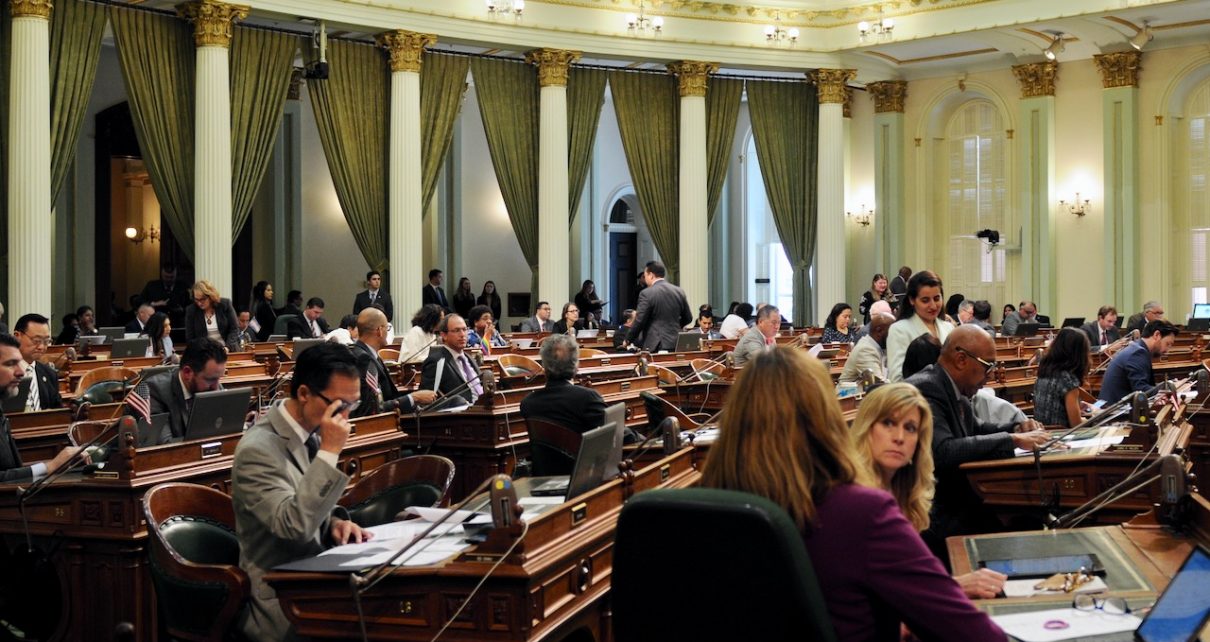
California State Assembly Chamber. (Photo: Kevin Sanders for California Globe)
Additional Rules on Drafting California Tax Legislation
Drafting tax bills in California can be tricky
By Chris Micheli, October 31, 2022 6:41 am
The drafting of bills that would add, amend, or repeal sections of the California Revenue and Taxation Code (CRTC) require special attention to a number of provisions. Whether they are technical or mechanical or substantive in nature, drafting tax bills in California can be tricky.
One of the main issues to determine is whether a bill is a tax levy. This is important because tax levies take effective immediately upon the Governor’s signature (and being chaptered). Of course, a tax levy can still have a delayed operative date for its provisions.
The rule for determining whether a bill is designated as a tax levy is to ask yourself: “What is the principal purpose of the bill?” If the principal purpose of the bill is to change the base, rate, or burden of a tax, then it will be designated as a tax levy, and the Office of Legislative Counsel will make that determination. On the other hand, if the bill contains multiple tax law changes, the bill may not be deemed a tax levy if that is not the principal purpose of the bill.
In general, a bill tax increases or decreases taxes, or a bill that creates or changes a tax expenditure program (e.g., a credit, deduction, exclusion, etc.), is a tax levy. However, a tax levy is not limited to just tax increases. Another important point is that a retroactive tax law change (which is allowed with special purpose language) cannot be a tax levy, so it will not take effect immediately.
Even though a tax levy bill can take effect immediately, it can also have a delayed operative date. An example of such a provision is contained in the following example: “This act provides for a tax levy within the meaning of Article IV of the California Constitution and shall go into immediate effect. However, the provisions of this act shall become operative on the first day of the first calendar quarter commencing more than 90 days after the effective date of this act.”
For property tax law changes, the bill has to specify to which lien dates the bill applies to, which begin each January 1: “The amendments made by the act adding this subdivision shall apply with respect to lien dates occurring on and after January 1, 2005.”
A second main issue is whether the bill must comply with CRTC Section 41. This section of the Revenue and Taxation Code requires any that proposes to authorize a new tax expenditure under the personal income tax law or corporation tax law, or an exemption from sales/use taxes, must contain three items: specific goals/objectives; detailed performance indicators; and, data collection requirements.
As such, a bill that creates a new credit, exemption, exclusion, or deduction in the income, franchise, or sales/use tax area must specify in statute the following:
- Specific goals, purposes, and objectives that the tax expenditure will achieve.
- Detailed performance indicators for the Legislature to use when measuring whether the tax expenditure meets the goals, purposes, and objectives stated in the bill.
- Data collection requirements to enable the Legislature to determine whether the tax expenditure is meeting, failing to meet, or exceeding those specific goals, purposes, and objectives. The requirements shall include the specific data and baseline measurements to be collected and remitted in each year the tax expenditure is in effect, in order for the Legislature to measure the change in performance indicators, and the specific taxpayers, state agencies, or other entities required to collect and remit data.
The Legislative Counsel’s Digest will contain language such as the following: “Existing law requires any bill creating a new or expanding an existing tax deduction to contain, among other things, specific goals, purposes, and objectives that the tax credit will achieve, detailed performance indicators, and data collection requirements.”
A third main issue is that tax bill must comply with certain drafting principles. The following is a brief description of the main drafting principles:
The Relating Clause is always the same, as follows: “…relating to taxation.”
The tax levy designation is always set forth at the end of the Title, as follows: “…to take effect immediately, tax levy.” In addition, the Legislative Counsel’s Digest always concludes with the following: “This bill would take effect immediately as a tax levy.” Finally, there is always a plus section at the end of the bill that contains the following language: “This act provides for a tax levy within the meaning of Article IV of the California Constitution and shall go into immediate effect.”
For sales/use tax bills, the existing law section of the Legislative Counsel’s Digest often begins with the same paragraph, such as the following:
Existing sales and use tax laws impose taxes on retailers measured by gross receipts from the sale of tangible personal property sold at retail in this state, or on the storage, use, or other consumption in this state of tangible personal property purchased from a retailer for storage, use, or other consumption in this state, measured by sales price. The Sales and Use Tax Law provides various exemptions from those taxes.
In addition, these types of bills will usually contain a “disclaimer” that no reimbursement will be provided to local agencies by the state. As a result, the Legislative Counsel’s Digest will contain language such as the following:
Existing law requires the state to reimburse counties and cities for revenue losses caused by the enactment of sales and use tax exemptions.
This bill would provide that, notwithstanding Section 2230 of the Revenue and Taxation Code, no appropriation is made and the state shall not reimburse any local agencies for sales and use tax revenues lost by them pursuant to this bill.
For personal income tax bills, the existing law section of the Legislative Counsel’s Digest often begins with the same paragraph, such as the following:
The Personal Income Tax Law imposes a tax on individual taxpayers measured by the taxpayer’s taxable income for the taxable year, but excludes certain items of income from the computation of tax.
A tax bill can contain a named act, as well as legislative findings and declarations, such as the following examples:
SECTION 1.
This act shall be known, and may be cited, as the Protecting Our Restaurants Tax Credit.
SEC. 2.
The Legislature finds and declares both of the following:
(a) Restaurants have faced a significant financial burden as a result of local ordinances closing businesses due to the COVID-19 pandemic.
(b) Financial assistance must be provided to reduce the number of restaurants that must permanently close because of a lack of profit and wages earned as a result of fewer customers.
When the tax bill contains language proposing to conform, or not conform, to federal tax laws, the specific Internal Revenue Code provision is cited, along with whether it applies (or does not apply), or any other changes made to the federal tax law for purposes of the state tax law provision(s). The following are examples of this type of language:
“Employee” includes self-employed individuals within the meaning of Section 401(c)(1) of the Internal Revenue Code. Code, relating to self-employed individual treated as employee.
Section 127 of the Internal Revenue Code Code, relating to educational assistance programs, shall not apply.
In addition, for federal tax law conformity bills, the Legislative Counsel’s Digest will contain language similar to the following: “The Personal Income Tax Law, in modified conformity with federal law, generally disallows passive activity loss and passive activity credits for any taxable year in computing taxable income.”
Finally, for bills affecting the Personal Income Tax Law (PITL) and the Corporation Tax Law (CTL), the same language is replicated in both areas of those laws. In other words, the same code section language in the PITL is found in a code section in the CTL, and vice versa. This is to ensure that taxpayers under the PITL are treated the same as taxpayers under the CTL, and vice versa.
- General Powers of the Boating and Waterways Department - July 22, 2025
- Termination of Domestic Partner Registration - July 21, 2025
- Duties of Pilots - July 20, 2025








3 thoughts on “Additional Rules on Drafting California Tax Legislation”